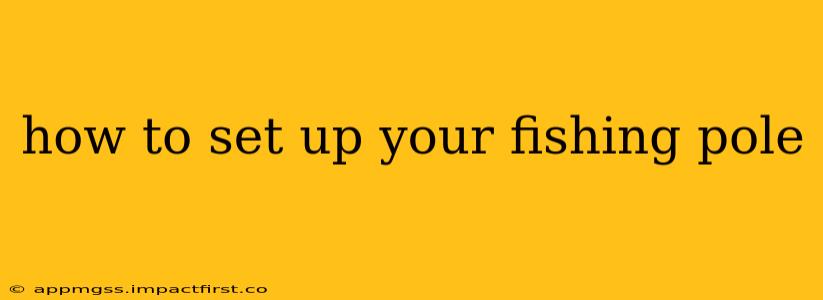Fishing can be a relaxing and rewarding experience, but before you can cast your line and feel that thrilling tug, you need to know how to properly set up your fishing pole. This guide will cover everything from choosing the right tackle to mastering the art of line spooling, ensuring you're ready for your next fishing adventure.
What Type of Fishing Pole Do You Have?
Before we dive into the specifics, it's crucial to identify the type of fishing pole you're using. This will significantly influence the setup process. The most common types include:
- Spinning Rods: These are versatile rods ideal for a variety of fishing styles. They feature a spinning reel attached to the rod's handle.
- Casting Rods: These rods are designed for longer casts and often paired with baitcasting reels, known for their power and precision.
- Spincast Rods: These are beginner-friendly rods with a closed-face reel that's simple to use and less prone to backlash.
- Fly Rods: Used for fly fishing, these rods require a specific setup involving a fly reel and specialized lines.
The instructions below primarily focus on spinning and casting rods, as they're the most common types. However, the core principles remain similar across different types.
Choosing the Right Line and Leader
Selecting the appropriate fishing line and leader is paramount for a successful fishing experience. Consider these factors:
- Line Type: Monofilament, fluorocarbon, and braided lines each offer unique properties regarding strength, visibility, and abrasion resistance.
- Line Weight (Test): This refers to the line's strength, measured in pounds. Choose a weight appropriate for the type of fish you're targeting and the fishing conditions.
- Leader Material: Leaders provide a more sensitive connection to the bait or lure and are often made from fluorocarbon for its invisibility to fish. The leader length will vary depending on your fishing technique.
Tip: Consult your local tackle shop for specific recommendations based on your fishing location and target species.
How to Spool Your Fishing Reel
This is a critical step often overlooked. Improper spooling can lead to line tangles, birds' nests, and lost fish.
Spinning Reels:
- Attach the Line: Thread the line through the guides on the rod and then onto the spool.
- Fill the Spool: Gradually fill the spool, ensuring even distribution. Leave a small gap at the top for backlashes.
- Tighten the Drag: Adjust your reel's drag to the appropriate tension. This allows the line to release under pressure, preventing line breakage.
Baitcasting Reels:
- Attach the Line: Similar to spinning reels, thread the line through the guides and onto the spool.
- Even Distribution: As with spinning reels, even distribution is key. Use a level-wind system if your reel has one.
- Adjust the Brake System: Baitcasting reels have a brake system that needs to be carefully adjusted to prevent backlash. Start with the brake settings fairly tight and adjust as needed.
How Do I Tie a Fishing Knot?
There are many different fishing knots, each with its strengths and weaknesses. Some popular choices include:
- Improved Clinch Knot: A versatile and reliable knot suitable for various line types.
- Palomar Knot: A strong and easy-to-tie knot.
- Uni Knot: Excellent for tying fluorocarbon leaders.
Practice tying these knots before heading out to the water. There are numerous online resources and videos that demonstrate proper knot tying techniques.
What are some common fishing knots?
Many different fishing knots serve various purposes. The choice often depends on the line type, lure, and fishing conditions. However, the Improved Clinch Knot, Palomar Knot, and Uni Knot are frequently cited as excellent options for their reliability and ease of tying. Always practice your knot tying until you can tie them consistently and securely.
How do I attach a swivel to my fishing line?
A swivel helps prevent line twist, particularly when using lures or baits that spin. To attach a swivel, simply tie a knot (like an Improved Clinch Knot) on one end of your main line and then another knot on the other end of the swivel. Then, connect your leader or lure to the other end of the swivel.
How tight should my drag be on my fishing reel?
Your drag should be tight enough to prevent the fish from stripping all your line but loose enough to allow for a smooth fight and prevent broken lines. The exact setting depends on the type and size of fish you're targeting, as well as the line strength. Start with a moderate setting and adjust as needed during the fight.
Final Thoughts:
Setting up your fishing pole might seem daunting at first, but with practice and understanding of the basics, you'll become proficient in no time. Remember to always check your equipment before heading out, and most importantly, enjoy the experience! Happy fishing!
